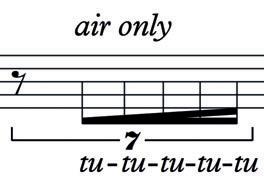EDITION WILHELM HANSEN
Outi Tarkiainen
DAY NIGHT DAY for Orchestra (2024) Score



Duration: c. 6:30 min.
DAY NIGHT DAY was jointly commissioned by the Berliner Philharmoniker, the Boston Symphony Orchestra and the Finnish Radio Symphony Orchestra. The first performances took place on 20, 21 and 22 February 2025 at the Philharmonie in Berlin, Germany, given by the Berliner Philharmoniker conducted by Marin Alsop. Full Score

Copyright © 2024 Edition Wilhelm Hansen A/S, Copenhagen
Music engraving in Sibelius
Publisher’s editor: Katrine Gregersen Dal
Edition Wilhelm Hansen, A/S Copenhagen Bornholmsgade 1A 1266 København K Denmark
www.wisemusicclassical.com
3 Flutes (Fl. 2 doubling Alto Flute in G, Fl. 3 doubling Piccolo)
3 Oboes (Ob. 3 doubling English Horn in F)
2 Clarinets in B flat (Cl. 3 = Bass Clarinet)
3 Bassoons (Bsn. 3 = Contrabassoon)
4 Horns in F
3 Trumpets in B flat
2 Tenor Trombones
1 Bass Trombone
Tuba
Timpani
Percussion (3 players)
1: Bass Drum
Crotales
Suspended Cymbal (small, medium, large)
2: Glockenspiel
Suspended Cymbal (small, large)
Crotales (arco)
3: Gong (large)
Rain Stick Suspended Cymbal (small)
Tam-tam
Thai Gong (c1)
Harp
Celesta
Strings
The score is not transposed
Orchestral parts are available on hire from the publisher
Day Night Day is an orchestral work about the northern light and ice that every winter invade the land but that reflect the early spring light in brilliant spectra. The work incorporates references to two Sámi melodies: a yoik of Láve Nigá Risten from the Teno region of Northern Finnish Lapland heralded by muted trumpets towards the beginning of the work, and a variation of the old South Sámi lullaby Sjamma, sjamma hummed at the end by the woodwinds. The musical themes spring from my forthcoming opera Day of Night jointly commissioned by Aalto Musiktheater Essen and Finnish National Opera and Ballet. The libretto of this opera based on the novel Halla Helle by the Sámi writer Niillas Holmberg is by Aleksi Barrière. The orchestral work Day Night Day was commissioned by the Berlin Philharmonic together with the Boston Symphony Orchestra and the Finnish Radio Symphony Orchestra.
Day Night Day on orkesteriteos pohjoisen valosta ja jäästä, joka talveksi valtaa maan mutta heijastaa kevättalven valon kirkkaina spektreinä. Teoksessa kuullaan viitteitä kahdesta saamelaisesta sävelmästä – tenolaisesta Láve Nigá Ristenin joiusta, jota raottavat alkupuolen sordinoidut trumpetit, ja lopun puupuhaltimien hyräilemänä muunnelma vanhasta eteläsaamelaisesta kehtolaulusta Sjamma, sjamma. Musiikilliset teemat kumpuavat tulevasta oopperastani Day of Night, (tilaajat: Aalto Musiktheater Essen ja Suomen Kansallisooppera), joka perustuu saamelaisen Niillas Holmbergin romaaniin Halla Helle ja jonka libreton on kirjoittanut Aleksi Barrière. Orkesteriteoksen Day Night Day tilasi Berliinin Filharmonikot yhdessä Boston Symphony Orchestran ja Radion Sinfoniaorkesterin kanssa.
Tempo markings: many factors can affect the choice of tempi, and the metronome marks shown are approximate, for guidance only.
General
Accidentials apply throughout the bar. Tremolo should always be as dense as possible. Trills should always be played up a semitone, unless otherwise specified (wt = wholetone). When vibrato markings are not specified, players can use their usual vibrato. All glissandi should start immediately at the beginning of the note value. The grace notes with a crossing line should be played before the beat. The grace notes without a crossing line should be played on the beat.


quarter tone, between natural and sharp
quarter tone, between natural and flat
l.v. let vibrate (allow to sound for as long as possible)
Strings

change very gradually from one sound or one way of playing (etc.) to another
When playing long sustained notes, the bow changes should always be imperceptible and made independently of the other players.
Woodwinds

Brass
Blow air through your instrument (into the mouthpiece), without producing a tone. Articulate/whisper as indicated.
Straight mutes should be used unless otherwise specified.

air only, blow air through your instrument, the resulting sound should be wind-like
Percussion
The choose of sticks is left to the musicians. Whether hard or soft, always choose sticks giving as much resonance as possible.
Celesta
If celesta pedalling is not specified, use the pedal lightly according the nature of the textures.
Harp
Harp sounds should always be allowed to ring as long as possible.
Subitopiùmosso,
Subitopiùmosso,